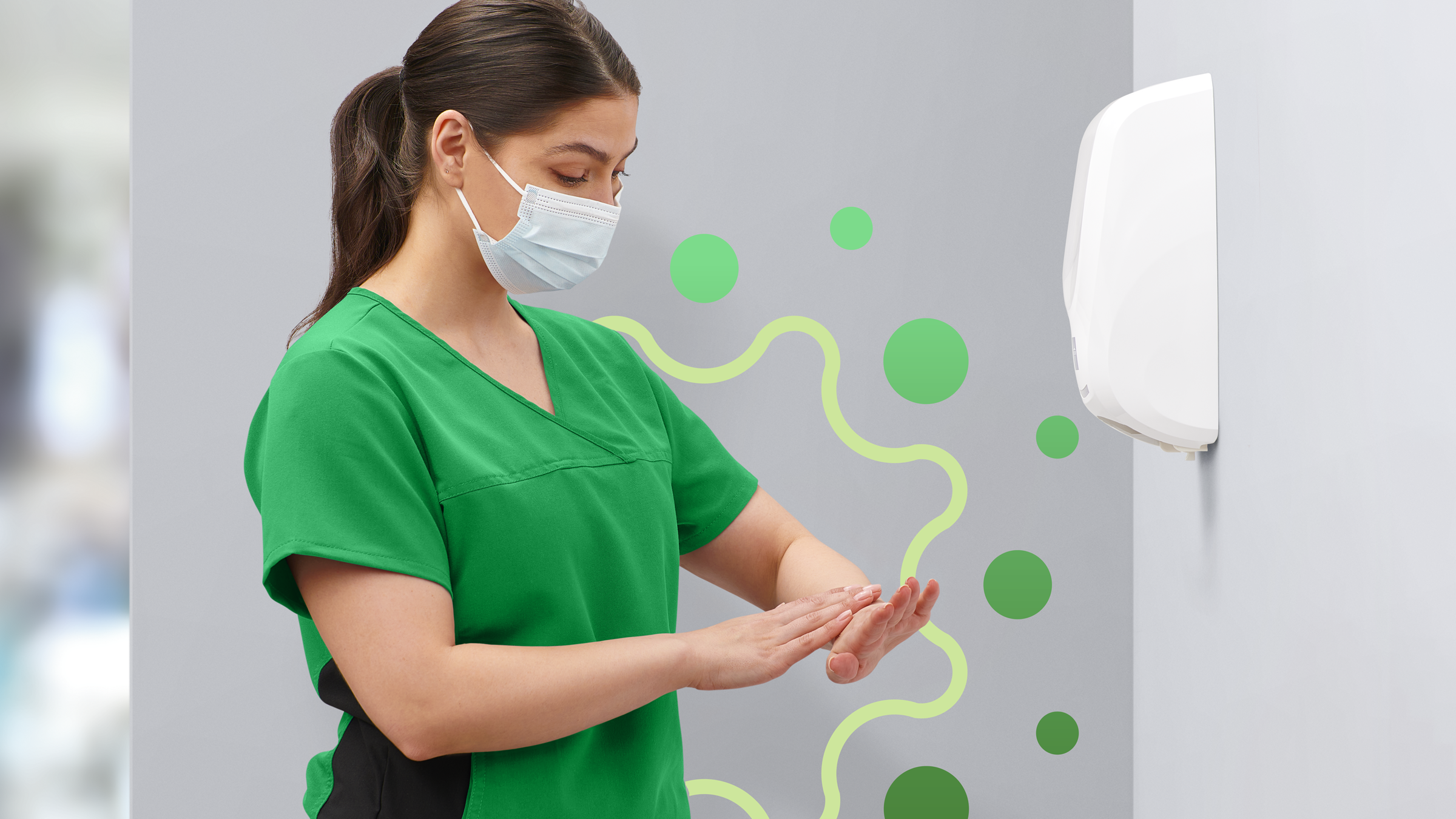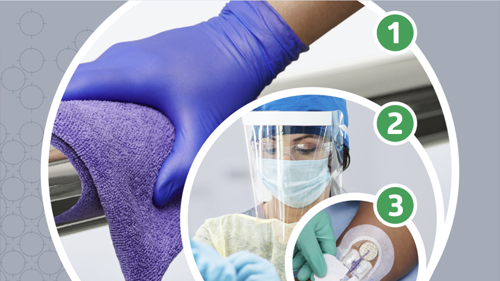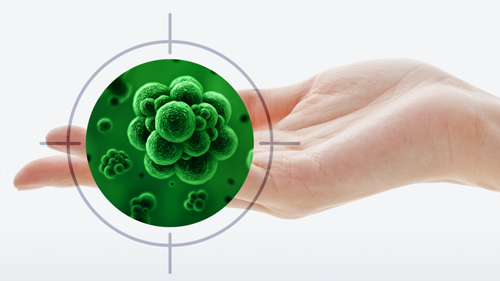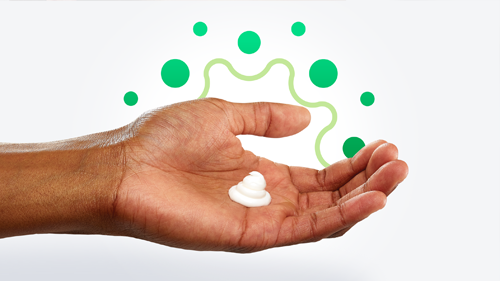Are you using hand hygiene products healthcare workers prefer?
Discover how moisturizing hand sanitizers can help increase compliance.

Clean hands are the most important factor in preventing the spread of pathogens in healthcare settings. Yet overall hand hygiene compliance rates in US hospitals average at about 40%. What is one of the top reasons healthcare workers don’t follow recommended practices? Hand hygiene products that cause skin irritation and dryness.1 Let’s examine how the right products can change behavior, help protect caregiver hands and ultimately result in the prevention of healthcare-associated infections (HAIs).
What happens when skin breaks down?
HAIs and occupational skin disorders are two important health issues that go hand in hand: Reduction in HAIs requires hand hygiene compliance.2 At the same time, frequent and repeated use of hand hygiene products, particularly soaps, alcohol-based hand rubs and other detergents, is a primary cause of chronic irritant contact dermatitis among healthcare workers.3
Check out these numbers:
- In observational studies conducted in hospitals, healthcare workers cleaned their hands an average of 5 to 30 times per shift. Certain nurses cleaned their hands up to 100 times per shift.1
- Approximately 25% of nurses report symptoms or signs of dermatitis involving their hands. As many as 85% give a history of having skin problems.2
The skin is an essential part of the innate immune system. The stratum corneum (SC) is the primary barrier to body water loss. A compromised SC barrier is more susceptible to entry/penetration by microorganisms. Studies show:
- Irritated hands had significantly more colony-forming units (CFUs) than normal hands
- Total bacteria counts were higher as skin damage increased
- Higher frequencies of colonization with Staphylococcus hominis, Staphylococcus aureus, gram-negative bacteria, enterococci and Candida were found in nurses with hand dermatitis
Importantly, the skin does not recover during time off, and caregivers return to work with significant skin compromise.2
“This can set off a whole cycle, because when caregivers’ hands are dry and irritated, they start scratching and causing open areas,” says Angela Zuick, Medline Director of Clinical Services.
Products with moisturizers are easier on skin
Although alcohols are among the safest antiseptics available, they can cause dryness and irritation of the skin. Ethanol is usually less irritating than n-propanol or isopropanol.3
One strategy for reducing the risk of irritation is to adopt the use of alcohol-based hand rubs and soaps containing emollients (moisturizers) and formulated for high-frequency hand hygiene.3
“Using a product that is specially formulated for high-frequency hand hygiene is key to driving healthcare worker compliance,” says Paul Alper, Medline vice president of patient safety innovation. “Not all hand hygiene products can make that claim.”
“If products in use are causing skin irritation, caregivers should speak up so other options can be explored.”

Angela Zuick
Medline Director of Clinical Services
Ethanol-based foam and gel formulations evaporate quickly on the hands and, when formulated appropriately, are highly effective against disease-causing pathogens. In addition, other hand hygiene products, such as exam gloves with coatings that soothe skin and hand lotions/moisturizers, can also help relieve irritation and improve skin condition.4
It’s important to note that routinely washing hands with soap and water immediately after using an alcohol-based hand rub may lead to dermatitis. Healthcare workers should be reminded that they should not wash their hands after each application of an alcohol-based hand rub.3 In addition, frequent hand washing in hot water and putting on gloves when hands are still wet also can cause skin irritation.
The improved barrier function associated with moisturizer use could also decrease the risk of allergic contact dermatitis. This risk can be further reduced using moisturizers that are fragrance-free, latex and CHG compatible and formulated without common sensitizers. Recent recommendations from the American Contact Dermatitis Society also support the use of moisturizers as part of an optimized hand hygiene routine.5
Make sure caregivers have a say in the products they use every day
When evaluating hand hygiene products for potential use in healthcare facilities, product selection committees should consider the relative efficacy of antiseptic agents against various pathogens and the acceptability of hand hygiene products by caregivers.
“When hand hygiene products are being tested in a healthcare facility, caregivers should be closely involved and encouraged to provide feedback,” says Zuick. “In addition, if products in use are causing skin irritation, they should speak up so other options can be explored.”
Product acceptance can be affected by characteristics such as smell, consistency, color and effect on skin irritation and dryness on hands.
When evaluating products, consider factors such as:
- Ease of application, spreading and rub-in
- Speed of drying
- Feel of skin after application
- Residual/build up after repeated application2
“Caregivers also need easy access,” says Alper. “Wall-mounted dispensers and other hand hygiene delivery systems such as tabletop pump bottles need to be at or near point of care to enable consistent healthcare worker use.”
In addition, dispenser performance should be reliable and consistent. This means the right dose or volume of product is dispensed every time, and dripping, clogging or leaking issues are non-existent.
“If dispensers are prone to drip or clog, compliance will likely decline, valuable product will be wasted, and walls and floors will be soiled and require attention from EVS staff,” adds Alper.
A total hand hygiene solution consisting of effective products formulated for high frequency use + reliable dispensing systems + a road map for where to place them within the points of care in the facility is a winning formula for driving higher compliance, staff satisfaction and better outcomes for patients/residents.2
Key takeaway
Hand hygiene is the most important factor in preventing HAIs. A main barrier to compliance is skin dryness and irritation. Alcohol-based hand rubs with emollients are effective at sanitizing and moisturizing hands, leading to greater caregiver acceptance. More widespread use of hand hygiene products that can help improve compliance will promote patient safety and help prevent infections.1
References:
- CDC. Hand Hygiene in Healthcare Settings-Core presentation. October 25, 2002. Available at: https://www.cdc.gov/handhygiene/download/hand_hygiene_core.pdf
- Visscher, M. O.; and Wickett, R. Randall. Hand hygiene compliance and irritant dermatitis: a juxtaposition of healthcare issues. International Journal of Cosmetic Science,2012,34, 402–415. Available at: Hand hygiene compliance and irritant dermatitis: a juxtaposition of healthcare issues
- CDC. Guideline for Hand Hygiene in Health-Care Settings. October 25, 2002. Available at: CDC guideline for hand hygiene in healthcare settings
- Data on file.
- Rivers, Jason K.; Arlette, John P.; DeKoven, Joel; et al.Skin care and hygiene among healthcare professionals during and after the SARS-CoV-2 pandemic. Sage Open Medicine. December 8, 2021. Available at: https://journals.sagepub.com/doi/full/10.1177/20503121211062795




